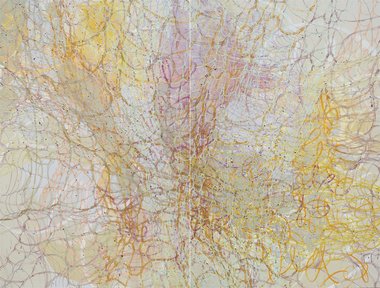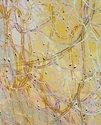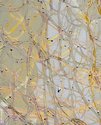Andrew Paul Wood – 13 May, 2011
Should we read the knitted motif (admittedly with many a stitch dropped and an enthusiastic kitten or two along the way) as something consciously feminine? That is difficult to say. It is tempting to interpret it as the injection of a distinct personality into abstraction in deliberate comment on the perceived patriarchal boys' club of the abstract tradition.
I must admit to being a fan of Katie Thomas, having seen her work develop over several years as she evolved from a sculptor in jewel-like resin to an abstract painter of great ability. Admittedly, my preference for painting as a medium is no secret, so perhaps I am somewhat prejudiced in the first place. However Thomas proves adept in both.
Throughout this transition, Thomas has retained the knitted stitch as a stylistic motif to peg her abstraction on. This gives the paintings strength and skeleton - like the onion domes lurking in the blobs and streaks of Kandinsky, or the empirical tree branches and New York streets at the heart of Mondrian’s transcendental grids. In paint this forms a kind of loose, densely layered organic grid allowing Thomas to explore the full interplay of dynamic tension, push-pull, figure and ground, and painterly field versus perspectival depth in an aesthetically pleasing and fluid way. And frankly that’s what abstract painting, freed of social, cultural and human context, is supposed to do. Hallelujah!
In particular I am drawn to Thomas’ sensitivity to the chromatic keys of her palette, treating it like musical timbre by weaving together muted and stridently saturated hues into a harmonious web - pale pinks, yellows, beiges, and then sudden and surprisingly rich royal purples. This might even be described as fluent “old skool” painting by someone clearly in love with the whole culture of painting - something that the University of Canterbury School of Fine Arts excels in encouraging. Indeed, Ilam is increasingly the last bastion of the artistic disciplines as discrete disciplines, not merely artistic genres or preferences.
Dare one dig up Walter Pater’s old fustian chestnut about all arts aspiring to the condition of music? Surely not! But here it seems to fit. The counterpoint of subtle hues and illusory flexing of surface create a kind of retinal hum - like the grounding drone of a church organ or bagpipes. It vibrates with the warmth and tactility of flesh. In these works for her MFA graduate show, Thomas is paying far more attention to the individual cells formed by the warp and weft of her paint, frequently resulting in some exquisitely delicate impressionistic effects that seem to float within the matrix of her composition. In effect, these cells are becoming gestalt entities in their own right on the canvas.
Should we read the knitted motif (admittedly with many a stitch dropped and an enthusiastic kitten or two along the way) as something consciously feminine? That is difficult to say. It is tempting to interpret it as the injection of a distinct personality into abstraction in deliberate comment on the perceived patriarchal boys’ club of the abstract tradition. With a few rare exceptions like Helen Frankenthaler and Gretchen Albrecht, women painters have either tended to avoid a genre that restricts personal expression, or have been deviously hounded out. These theoretical games are, however, unnecessary to the full appreciation of these works.
The show has been hung to take full advantage of the cosy dimensions of the space. If I were to have a criticism, it would be that the works are a tad flat. The paintings cry out to be more densely textured, or to make more play of the sculptural and gestural qualities of paint, counterpointed against the possibilities of its decorative surface. But this is one instance where I surprise myself in realising that my own personal niggling doubts really do not matter in the least to how others should view and appreciate these paintings.
Andrew Paul Wood





 Two Rooms presents a program of residencies and projects
Two Rooms presents a program of residencies and projects Advertising in this column
Advertising in this column



This Discussion has 0 comments.
Comment
Participate
Register to Participate.
Sign in
Sign in to an existing account.